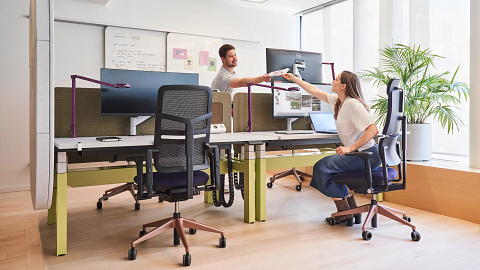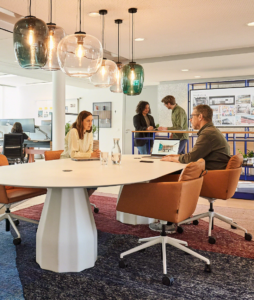In a world still adjusting to hybrid work and evolving definitions of workplace “normal,” one truth continues to stand strong: the office matters. Not just as a place to plug in a laptop, but as a hub for collaboration, innovation, and connection. As leaders, we can’t afford to overlook how the design of our spaces directly impacts performance, retention, and wellbeing.
In her article “5 Reasons to Go Into the Office,” Dr. Tracy Brower highlights insights about why returning to shared workspaces is essential—not just for businesses, but for people. And when we pair that with some powerful data, a clear picture emerges: thoughtful space planning is no longer a nice-to-have—it’s a strategic imperative.

Top Performers, Top Priority
High performers are up to 400% more productive than average employees. That’s not a typo—400%. And yet, 30% of top performers leave within the first year. In a tightening labor market, we must ask: are our workplaces giving these individuals the environment they need to thrive?
Office design plays a pivotal role here. Private spaces for focus, social zones for connection, and purposeful layout planning can make the difference between an employee who stays and grows, and one who quietly exits.
Proximity Breeds Productivity
When people are physically together, they learn more, innovate faster, and produce better results. In fact, sitting within 25 feet of a high performer can boost someone’s performance by 15%. Even being within 65 feet of a colleague leads to measurable knowledge spillover.
This is where space planning becomes more science than art. Open environments that promote visibility, centralized hubs for collaboration, and flexible zones for quick huddles can all support organic learning and shared success. It’s not about going “back” to the office—it’s about designing a better one.
 Designing for Connection
Designing for Connection
A surprising yet powerful statistic: 22% of millennials say they have no close friends. And for many adults, the office is one of the primary places they build relationships. The value of a workplace isn’t just tied to tasks—it’s about human connection.
Intentional office design can foster this sense of community. Whether it’s shared cafés, welcoming lounge spaces, or areas designed for chance encounters, creating moments for connection is just as important as designing for productivity.
Making the Case for Intentional Design
The workplace is no longer just where we work—it’s where we learn, grow, connect, and thrive. As we look to the future, leaders must prioritize environments that reflect the evolving needs of their people.
At the end of the day, office design isn’t just about aesthetics—it’s about performance. It’s about creating spaces that help people do their best work and feel their best doing it.
Because when we design with intention, we don’t just build offices—we build culture, community, and competitive advantage.